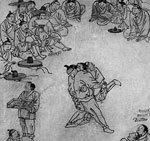Taekwondo 태권도Taekwondo Preschool
Korean martial arts are military practices and methods which have their place in the history of Korea but have been adapted for use by both military and non-military personnel as a method of personal growth or recreation.
About Moo Duk Kwan Taekwondo 무덕관
Korean martial arts are military practices and methods which have their place in the history of Korea but have been adapted for use by both military and non-military personnel as a method of personal growth or recreation.
Moo Duk Kwan Taekwondo is a modern Korean martial art formed in April 1965 by Kim Young Taek, Hong Chong Soo, and Lee Kang Ik.
Meaning
The name Moo Duk Kwan means "School of Martial Virtue"
- Moo – military, chivalry, martial; within the ideograph the inner part of the symbol is the word for "stop" and the outer part means "weapon"
- Duk – benevolence, virtue, goodness, commanding respect; within the ideograph on the left it means "little steps" or "to happen", and on the right the character means "moral"; thus moral steps or perhaps virtuous conduct
- Kwan – large building, palace, library; again within the ideograph the left part looks like a roofed building and technically means "to eat" (under a roof).

History
Moo Duk Kwan is the name coined by Hwang Kee for his martial arts school established in Korea November 9, 1945. Today Moo Duk Kwan and Hwang Kee's fist logo are federally registered trademarks 3,023,145 and 1,446,944 and 3,119,287 of Hwang Kee's licensed successor organizations. Hwang Kee named the first martial art system he taught in his Moo Duk Kwan schools Hwa Soo Do. Later Hwang Kee modified the content of his martial art system and named it Tang Soo Do and eventually he modified his martial art system again and adopted the name Soo Bahk Do to reflect the significant changes incorporated into his system including a new series of hyungs.
In 1961 the Korean government initiated a movement to unify all of its country's martial arts schools under one governing body. This body would originally be called the Korean Tae Soo Do Association and later renamed the Korean Tae Kwon Do Association. The stated purpose was to unify the Kwans and allow for growth of this newly named Korean martial art.
"A Modern History of Taekwondo", reprinted records and minutes of the meetings of the Kwan Unity committee indicating that Hwang Kee was upset that he would not lead the unified group.
In March 1965 three of Hwang Kee's senior students, Kim Young Taek, Hong Chong Soo, and Lee Kang Ik, led a significant number of practitioners from Hwang Kee's Moo Duk Kwan schools to join the Tae Kwon Do Kwan Unity Movement and in April 1965 Lee Kang Ik became the president of their group.
The Moo Duk Hae is a social friendship club that endorses the Kukkiwon curriculum. Every year the Moo Duk Hae has an anniversary celebration in Korea, where members from all over the world attend. Attendees include some from the Soo Bahk Do Moo Duk Kwan.
The Present Day
Hwang Kee's Moo Duk Kwan schools have been the birthplace of many esteemed martial artists who today promote a multitude of different martial art systems including Tang Soo Do, Soo Bahk Do, Tae Kwon Do and more. Many practitioners with lineage back to Hwang Kee's Moo Duk Kwan schools consider each other as brothers and may attend each other's special events and tournaments. As founder of the 1st Moo Duk Kwan school on November 9, 1945 Hwang Kee is the progenitor of many practitioners worldwide and who express great admiration for him and his achievements in the martial arts.
There are five tenets defined in the International Taekwondo Federation (ITF) and several more in World Taekwondo (WT).
Courtesy ( 예의 ye-ui ): "Showing courtesy to all, respecting others, having manners as well as maintaining the appropriate etiquette at all times, both within and outside the dojang (도장) (designated training area)." View Taekwondo Tenets »
RESOURCES
This article uses material from the Wikipedia article "Moo Duk Kwan Taekwondo", which is released under the Creative Commons Attribution-Share-Alike License 3.0.












